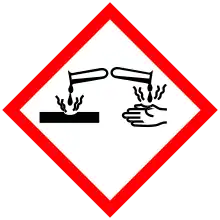Rubidium hydroxide
Rubidium hydroxide is the inorganic compound with the formula RbOH. It consists of rubidium cations and one hydroxide anion. It is a colorless solid that is commercially available as aqueous solutions from a few suppliers. Like other strong bases, rubidium hydroxide is highly corrosive. Rubidium hydroxide is formed when rubidium metal is dissolved in water.[2]
| Names | |
|---|---|
| IUPAC name
Rubidium hydroxide (+1) | |
| Identifiers | |
3D model (JSmol) |
|
| ChEBI | |
| ChemSpider | |
| ECHA InfoCard | 100.013.806 |
PubChem CID |
|
| RTECS number |
|
| UNII | |
CompTox Dashboard (EPA) |
|
| |
| |
| Properties | |
| RbOH | |
| Molar mass | 102.475 g·mol−1 |
| Appearance | white solid, hygroscopic |
| Density | 3.1 g/mL at 25 °C |
| Melting point | 382 °C (720 °F; 655 K) dec |
| Boiling point | 1,390 °C (2,530 °F; 1,660 K) |
| 173 g/100 mL (30 °C) | |
| Solubility | soluble in ethanol |
| Basicity (pKb) | -1.4[1] |
| Thermochemistry | |
Std enthalpy of formation (ΔfH⦵298) |
−413.8 kJ/mol |
| Hazards | |
| Main hazards | Corrosive |
| GHS pictograms |  |
| NFPA 704 (fire diamond) | |
| Flash point | Non-flammable |
| Related compounds | |
Other cations |
Lithium hydroxide Sodium hydroxide Potassium hydroxide Cesium hydroxide |
Related compounds |
Rubidium oxide (+1) |
Except where otherwise noted, data are given for materials in their standard state (at 25 °C [77 °F], 100 kPa). | |
| Infobox references | |
Uses
Rubidium hydroxide is rarely used in industrial processes because potassium hydroxide and sodium hydroxide can perform nearly all the same functions of rubidium hydroxide. Metal oxide catalysts are sometimes modified with rubidium hydroxide.[2]
See also
References
- "Sortierte Liste: pKb-Werte, nach Ordnungszahl sortiert. - Das Periodensystem online" (in German).
- Lenk, Winfried; Prinz, Horst; Steinmetz, Anja (2010). "Rubidium and Rubidium Compounds". Ullmann's Encyclopedia of Industrial Chemistry. Weinheim: Wiley-VCH. doi:10.1002/14356007.a23_473.pub2.
- "Rubidium compounds: dirubidium oxide". WebElements: the periodic table on the web. WebElements. Retrieved 16 November 2011.
- "Rubidium hydroxide". ChemExper Chemical Directory : catalog of chemicals and suppliers. ChemExper. Retrieved 16 November 2011.
This article is issued from Wikipedia. The text is licensed under Creative Commons - Attribution - Sharealike. Additional terms may apply for the media files.

